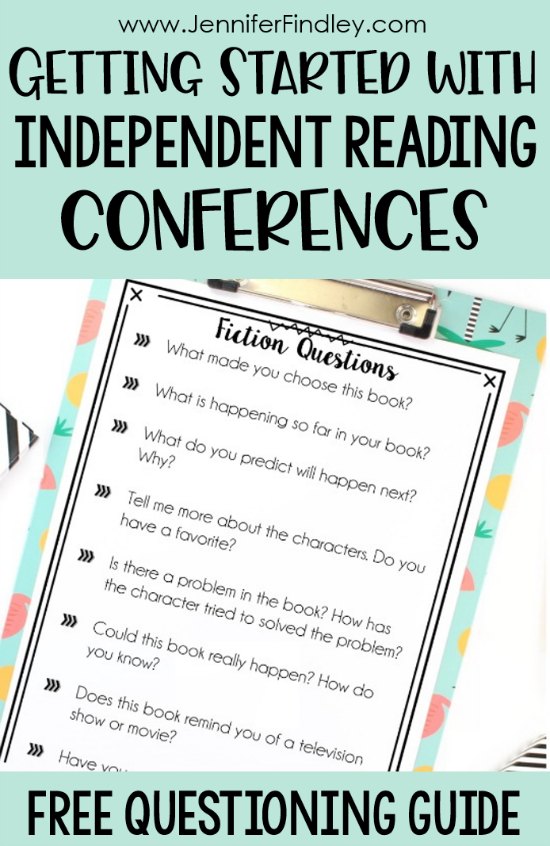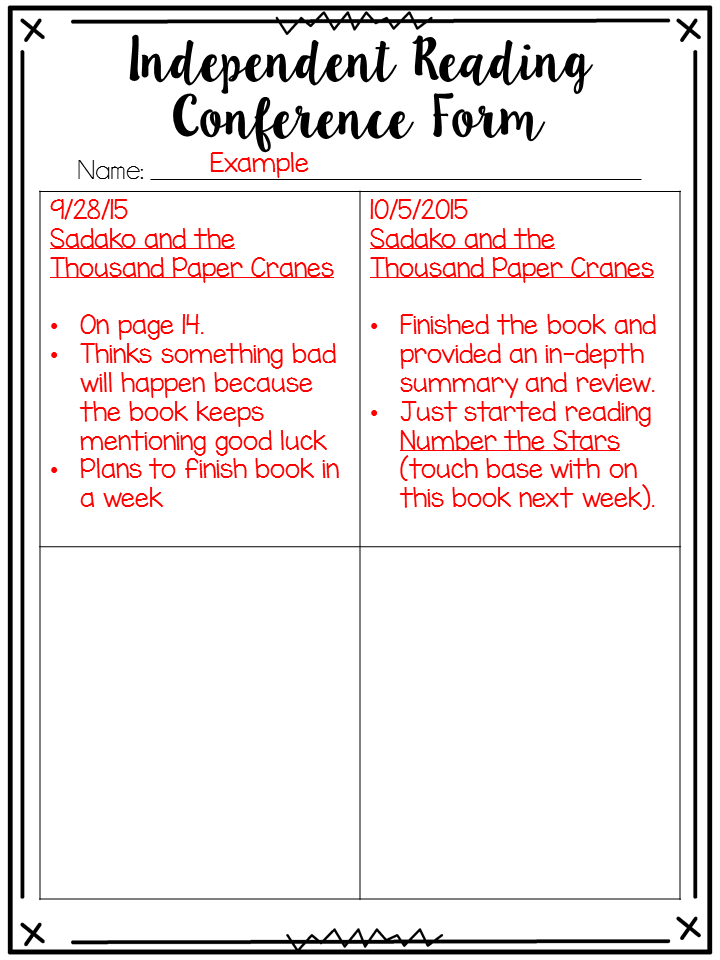One of my favorite parts of Reading Workshop is doing independent reading conferences. I am an avid reader, so I love getting the chance to talk with students about what they are reading. However, I do remember struggling with when and how to go about doing independent reading conferences in the busy day. I wanted to share some ideas with you about how to get started with independent reading conferences in your classroom.

When Do You Conduct Independent Reading Conferences?
Figuring out when to do independent reading conferences is the biggest struggle teachers face and one of the reasons many teachers don’t do them. I do guided reading groups so my tips are based on that. However, if you use a basal, you may find these helpful as well.
In the first few weeks of school (before guided reading groups start), I focus my energy on independent reading conferences. I use this time to get the students used to them and to get to know my students as readers. In the beginning, your conferences will take a little longer than usual, but once you and your students get used to them, you will have them fine tuned to less than 5 minutes.
Once guided reading groups start, I have my students bring their independent reading books to the guided reading table. They know to continue reading their independent book while they wait for the group to begin.
I do 1-2 reading conferences a day before we start the group. One a day is the best, but if you have a group of more than 5 kids, you have to do 2 on some days.
How Do You Conduct Independent Reading Conferences?
Now that you have some ideas about when to do independent reading conferences, let’s move to the how. When I do an independent reading conference, I try to sit at the student’s level and beside him or her. This is not always practical when doing them at the guided reading table, but I try to lean in and really get on the same eye level with the students while we are discussing the book.
Then I follow these general guidelines to conduct the initial conference on a book (printable download available at the end of this post).
- Ask the student if you may see the book they are reading. Glance over the front cover and maybe even skim the back of the book. This will quickly give you the gist of the book.
- Based on your initial first glance at the book, make a comment about the book followed by a prompting question to start the conversation. Examples:
- Oh, I have heard of this book. I have always wanted to read it.
- People say _______. What do you think about it?
- I read this book last year. What part are you at?
- Some of my students really enjoyed this book last year. What do you think so far?
- This (mention something on the cover) looks interesting. What is happening here?
- I think (topic of the book) is fascinating/intriguing/interesting. What are you thinking so far?
- Once you open the conference like this and the students get used to this type of dialogue about books, the conversations will start flowing naturally. However if you still have some reluctant students, I have a list of guiding questions that you can use for fiction and nonfiction. You can download these at the bottom of this post.
Once you do that initial conference, the following conferences on that book will be super easy. Jot yourself some notes on what you discussed with the students to help you remember. I usually ask a question like “What do you think will happen next?” for fiction stories and then quickly jot down what they said.
Then I open the conference with “So last time you said ________. Did that happen?” For nonfiction, I may ask something like “What do you still want to learn?” and then I would ask them if they learned it to open the next conference.
In regards to the form I use, I keep it very simple. I write the date, the title, the page number, quick prompt to get me going on the next conference, the student’s plan with the book and any other notes in regards to their reading behaviors or reading strategies. Here is an example.
Before I begin a conference, I turn to my form and quickly reread my last entry to know where to start the conference. This method is super efficient and really helps create a culture of readers.
Independent Reading Conferences Questions and Forms
I hope this post has provided you with some resources you needed to get independent reading conferences going in your classroom. Click here on the image below to download all the forms mentioned in this post.
To read more about how I teach reading click on the links below:
How I Teach Reading in 5th Grade
Holding Students Accountable for Independent Reading
Reading Centers for Upper Elementary
Guided Reading Binder (FREE Forms)
Guided Reading Supplies for Upper Elementary
Do you independent reading conferences in your room? Do you have any tips that help make them successful and time-efficient? Let me know in the comments!











Thank you! These forms are great!
You’re welcome! I hope you are able to use them.
Hey these ideas are super inspirational. I feel like it is way too late in my school year to use them for this years class, however, I’d love to start this culture with my class next year. The idea of sitting one-on-one with students talking about their reading books makes me smile big time!! haha
I am trying to download the documents but I keep getting a 502 error. I’m bummed because I was hoping to start using these asap. Thanks for any help and for all the resources you post!
Hi Rebecca, try this link: https://drive.google.com/file/d/0B8DtIUhMGc9qZ0xkcjRXZUY0NWc/view
If that doesn’t work, feel free to email me at [email protected].
HI Jennifer!
Just found your blog last week and feel in love with it. Do you have any guided reading lesson plan template? I printed and began using the guided reading notes handouts. I looked on your TPT store and did not find anything there either. I did find other goodies there though!! Thank you so much and know that you have a new follower!
Hi Jennifer, thank you so much! I don’t have any guided reading resources other than the notes handout at this time. However, I have a blog series planned out where I will break down how I plan for guided reading, how I organize my groups, management tips and more. I hope to start the series in January. Thanks again!
Thank you, this blog is amazing!! I just got moved from a completely different high school subject to 8th grade ELA for this upcoming fall. There isn’t even a curriculum yet, and having never taught reading or English I’m feeling so overwhelmed. I had no idea HOW to even teach this stuff. I’ve found a lot of information, but yours is the first blog that I’ve found that has actually answered the questions I have on how to approach teaching this subject. You are awesome, and I so appreciate that you are willing to share your knowledge!!!
Hi Jennifer! Thank you so much for this! I love the example and the free prinables – they are awesome! I am looking forward to implementing this with my new 5th graders! Keep up the awesome work, and thanks for sharing! 🙂
I love your ideas! I am going to try these! I love the way that you explained everything. Thank you so much.
Thank you for sharing your clear, refined forms! Awesome!
I’m so glad I stumbled upon this blog. I am a literacy coach in an elementary school and will be getting my teaches started on the inclusion of a structured independent reading component in their literacy block. Your tips on how to get started will be quite useful. Thanks so much!
Awesome, love these. It’s familiar to look at this and read and say that makes sense and I sorta do this but really this more jumps out at me and says, “yes, this is exactly and wonderful systematic approach and an easy reference to then make data-based decisions!
Thank you for sharing your ideas and resources! Can you tell me how many minutes your class is? I’m thinking of how I would add this to a 50-minute class for 6th graders. Any ideas welcome!
Hi Linda, I have about 90 minutes for reading. It would be more difficult on a 50 minute schedule but you could something similar to an A/B schedule where you do conferences when you are on the B schedule. Here is an example:
A Schedule:
20 Minute Mini Lesson
30 Minutes Independent Reading and Skills Groups/Guided Reading
B Schedule
20 Minute Mini Lesson
30 Minutes Independent Reading and Conferences
Hope this gives you more ideas!
Jennifer, I follow you all the time and as an experienced teacher, but not one well organized, I appreciate all you’ve done to keep me organized. Thanks for helping out the teaching profession with your insights!
You have great ideas! Thank you for sharing and inspiring. I am exited to use your ideas and forms for keeping students accountable for Read to Self and I look forward to implementing the Independent Reading Conferences.
Hi Jennifer…I am so thankful to find you! I am teaching Reading, Vocabulary and Spelling for the first time in years…trying to get organized. Unfortunately I only have 40 minutes for all 3. I don’t have to spend too much time on Spelling (vocabulary and spelling alternating weeks) so I can mainly focus on Reading. Would you help me with managing this? I am trying to assess their skills before starting a whole group novel. Would you do a 15-20 mini lesson with whole group then meet with kids on whet they are reading? Are kids working on seat work while I meet with individuals?
Is there a way to purchase your resources WITHOUT using tPt? Our district frowns upon tPt and my principal refuses to purchase from it.
Hi Debbie, we are working on adding a shop to our website. It should hopefully be ready by December. Thanks for asking!